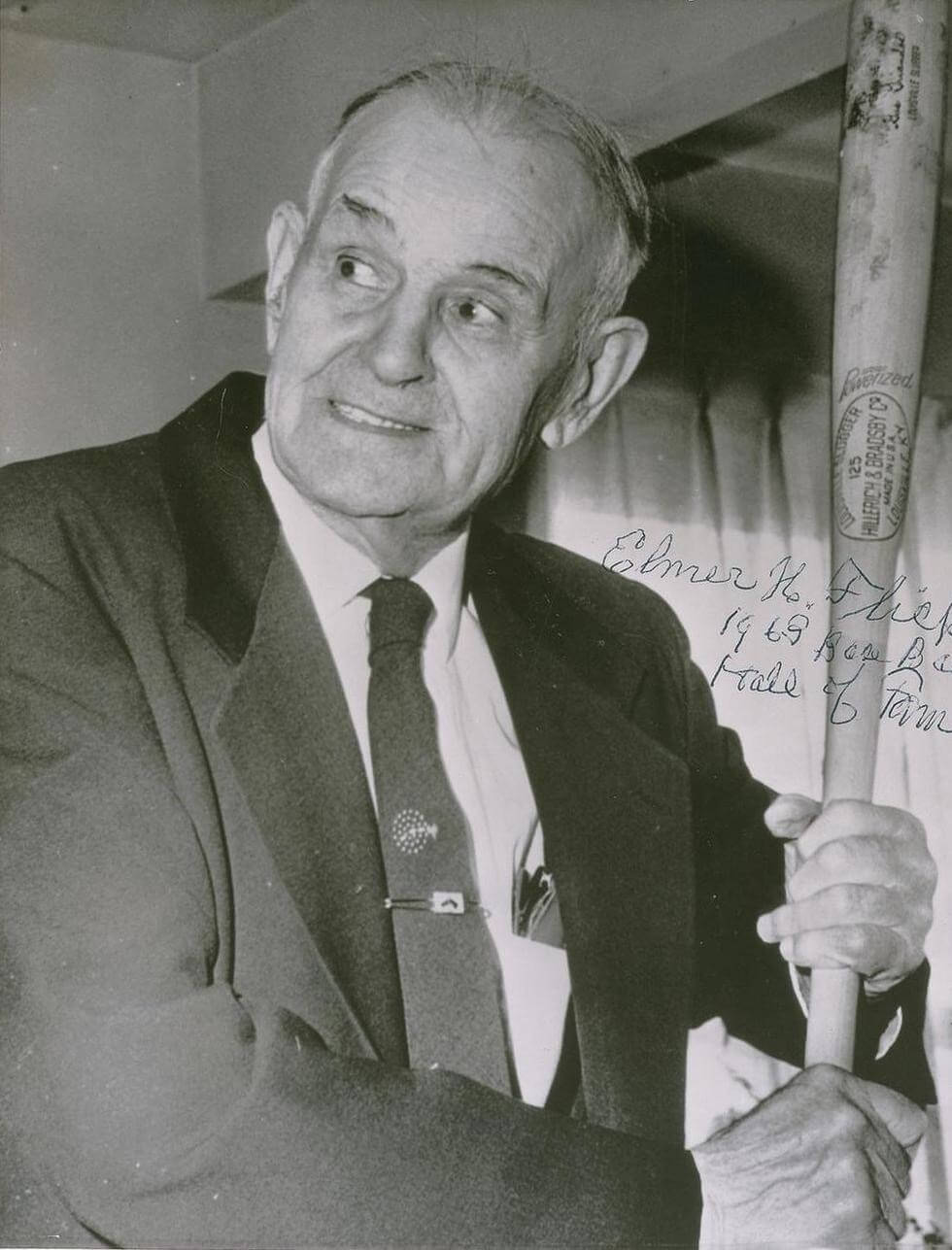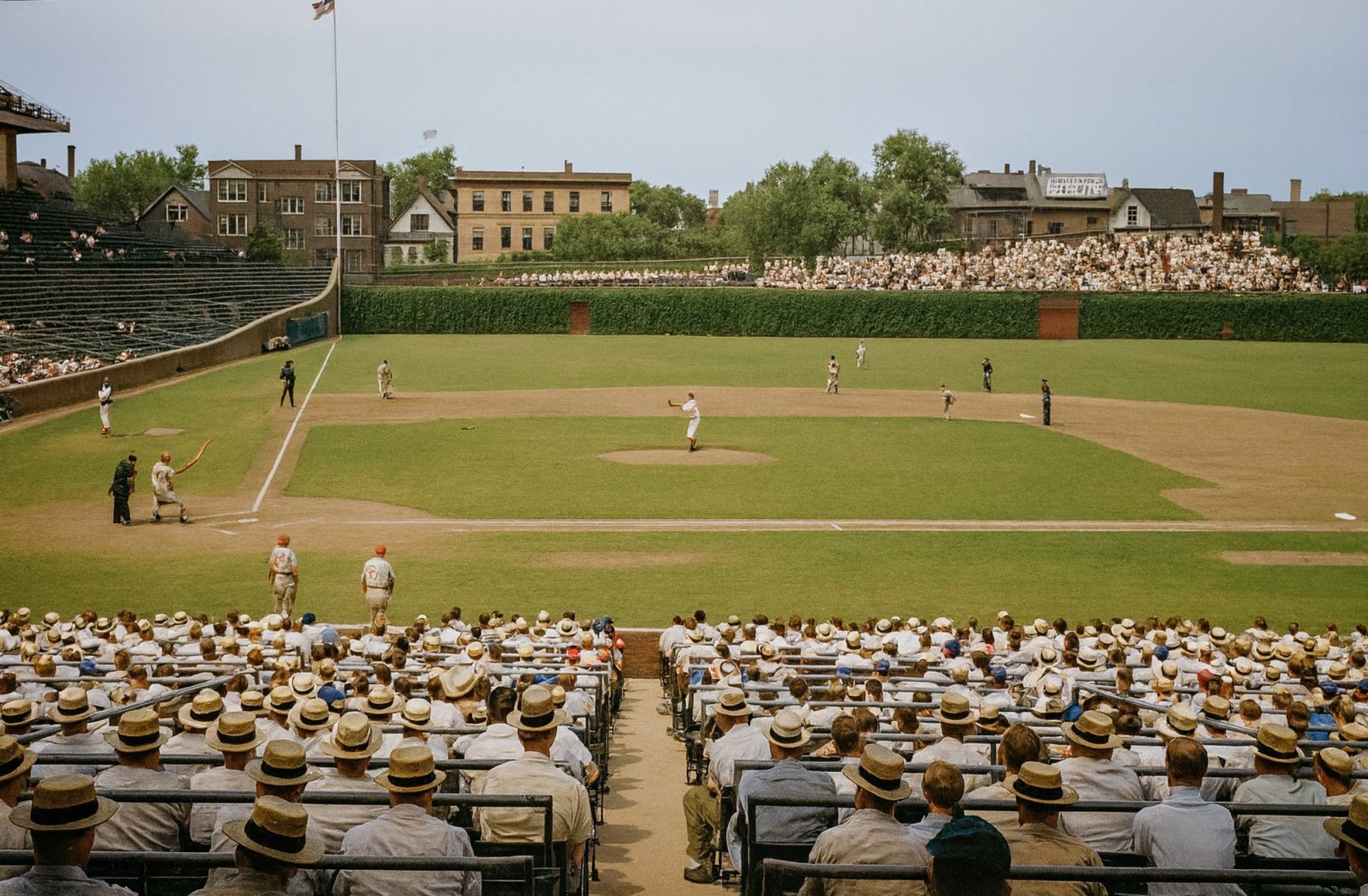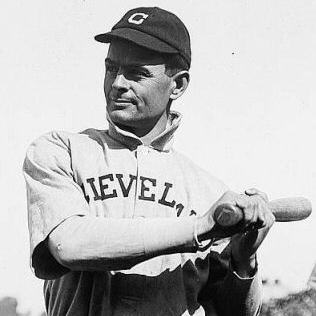Panoramic Photo Above:
Wrigley Field, Chicago

Baseball History Comes Alive Now Ranked As a Top Five Website by Feedspot Among All Baseball History Websites and Blogs!
(Check out Feedspot's list of the Top 35 Baseball History websites and blogs)
Guest Submissions from Our Readers Always Welcome! Click for details
Visit the Baseball History Comes Alive Home Page
Subscribe to Baseball History Comes Alive
Free Bonus for Subscribing:
Gary’s Handy Dandy World Series Reference Guide
Be honest…Have you ever heard of Elmer Flick? If so, did you know he’s in the Hall of Fame? It doesn’t seem right to include a Hall of Famer in the “Forgotten Stars” category, but I think it applies to Elmer Flick, probably the least recognized HOFer. Mike Janacek returns today and attempts to set the record straight with an interesting account of Elmer’s life and career. -GL
Another Edition of Baseball’s Forgotten Stars
Elmer Flick:
‘The Demon of The Stick’
Renowned for his speed and bat control, Elmer played thirteen seasons with Philadelphia and later, Cleveland. Born in Bedford, Ohio, on January 11, 1876, he grew up on a farm and attended Bedford High School, where he wrestled, boxed, played football, and was the baseball team’s catcher.

Elmer’s baseball career happened almost by accident. At fifteen, he went to the train station to see the Bedford semi-pro team as they left for a doubleheader. When one of the players did not show up, Elmer was invited to join the tea. He eagerly accepted. Without a uniform or footwear, he played well in both games. He then joined the team and played semi-pro baseball until 1898. “In my first game for Youngstown, I hit a ninth-inning homer with one on to win, 2-1. That’s when they first started to call me ‘Elmer Fick, the demon of the stick’.” Elmer Flick 3
Spotted and signed as a reserve by manager George Stallings of Philadelphia, Flick became a starter, replacing Sam Thompson. He finished with a .302 average, eight home runs, 81 RBIs, and 13 triples. The following season, he improved to .342, scored 98 runs, drove in 98, but suffered a serious knee injury late that year.
The 1900 season seemed like Elmer’s year. He battled with Honus Wagner for the batting title until the last day of the season. His 110 RBIs led the League. His .367 batting average was good for second place. He had 11 home runs, one shy of the leader, Herman Long. Highlights also included a .545 slugging percentage, 59 extra base hits, and 297 total bases, all second in the League. During the season, he got into a fist fight with Nap Lajoie, which resulted in Lajoie missing five weeks with a broken thumb. (Remember, Flick was a boxer and /wrestler in high school.) Honus Wagner, who won the batting title, said, “I’ve had a lot of thrills, but don’t think I was ever happier than in 1900 when I won after battling Elmer Flick to the last day of the season for the title.”4

Flick, along with several Phillies teammates, made the jump to the American League in 1901, playing for the other Philadelphia team, the Athletics. The Phillies obtained an injunction prohibiting any player under contract to the Phillies from playing for another team. As this injunction was not enforceable in Ohio, Flick signed with Cleveland and avoided traveling to Pennsylvania. Elmer was respected for his solid batting and speed on the bases, usually ranking in the top in most offensive categories. In 1904, he tied for the lead in stolen bases and led the League in 1906. His 1905 batting average was the League high, as was his .462 slugging percentage.
In 1906, Elmer Flick played a league-high 157 games, leading the American League in plate appearances (700), at-bats (624), runs (98), triples (22), and tied for stolen bases (39).

Despite his success, Flick was reportedly unhappy with the team, prompting the Cleveland Naps to consider trading him to the Detroit Tigers for Matty McIntyre. Before the 1907 season, Detroit proposed a deal sending 21-year-old Ty Cobb to Cleveland in exchange for Flick. Tigers manager Hughie Jennings had grown frustrated with Cobb’s difficult temperament, but the Naps refused to part with their star outfielder. Instead, they offered Bunk Congalton, an offer the Tigers declined.
In early 1908, Elmer began suffering from stomach pain. He left training camp and returned home to Cleveland, playing in only nine games that season and missing the start of the 1909 campaign. Weighing only 130 pounds, Flick appeared in only 24 games in 1910. After Cleveland acquired Joe Jackson from Philadelphia, it no longer needed Flick’s services and traded him to Kansas City. Elmer refused to report, and with no one offering him an opportunity, he returned to Toledo in the minor leagues. After finally retiring, Elmer returned to Bedford, raised horses, hunted, built and sold houses, and scouted for Cleveland. Flick was elected to the Baseball Hall of Fame in Cooperstown in 1963.6
When Branch Rickey called to let him know he had been selected, Elmer did not believe him at first. He said that he did not even realize that he was being considered for election at the time.7 Elmer Flick was the oldest living inductee in Hall of Fame history. Elmer passed away from heart failure in 1971, two days shy of his 95th birthday.
Over the course of 1,483 career games, Flick posted a .313 batting average, collecting 1,752 hits, 164 triples, 330 stolen bases, and 756 runs batted in (RBIs).
Mike Janacek
- Angelo Louisa, “Elmer Flick,” Baseball Biography Project, Society for American Baseball Research (SABR), accessed September 12, 2025, https://sabr.org/bioproj/person/elmer-flick/.
- Angelo Louisa, “Elmer Flick,” Baseball Biography Project, Society for American Baseball Research (SABR), accessed September 12, 2025, https://sabr.org/bioproj/person/elmer-flick/.
- National Baseball Hall of Fame and Museum, “Elmer Flick,” Baseball Hall of Famers, accessed October 27, 2025, https://baseballhall.org/hall-of-famers/flick-elmer.
- Fred Lieb, “Rickey, Honus Remembered Flick,” Petersburg Times, January 27, 1971, accessed November 6, 2013.
- 1906 American League Batting Leaders,” Baseball-Reference.com, accessed September 12, 2025, https://www.baseball-reference.com.
- Jeff Carroll, Sam Rice: A Biography of the Washington Senators Hall of Famer (Jefferson, NC: McFarland, 2007), 207.
- David L. Fleitz, Ghosts in the Gallery at Cooperstown: Sixteen Little-Known Members of the Hall of Fame (Jefferson, NC: McFarland & Company, 2004), 126.
Fleitz, David L. Ghosts in the Gallery at Cooperstown: Sixteen Little-Known Members of the Hall of Fame. Jefferson, NC: McFarland & Company, 2004.
Lieb, Fred. “Rickey, Honus Remembered Flick.” St. Petersburg Times, January 27, 1971. Accessed November 6, 2013.
Louisa, Angelo. “Elmer Flick.” Baseball Biography Project. Society for American Baseball Research (SABR). Accessed September 12, 2025. https://sabr.org/bioproj/person/elmer-flick/.
We’d love to hear what you think about this or any other related baseball history topic…please leave comments below.
Gary Livacari
Subscribe to Baseball History Comes Alive. FREE BONUS for subscribing: Gary’s Handy Dandy World Series Reference Guide. https://wp.me/P7a04E-2he
Information: Excerpts edited from



Well done Mike! That Elmer Flick had to wait 55 years before he was finally enshrined as me shaking my head!
Elmer was a fine ballplayer, but I think he’s light for the Hall. Then again, I’m much tougher than most voters, as I would toss close to half of the current enshrinees!
Thanks Mike, I’m with you!